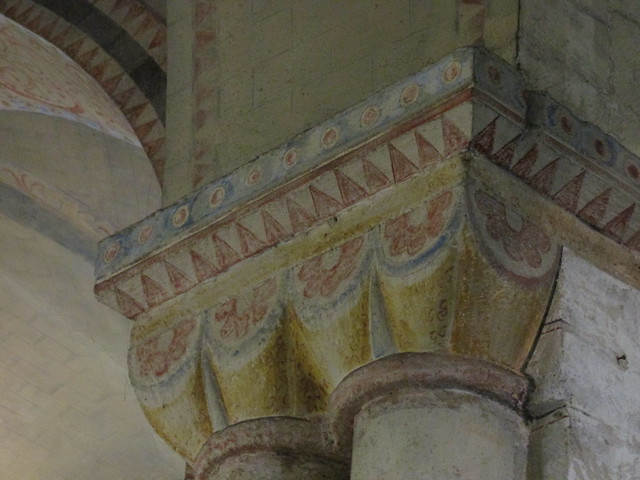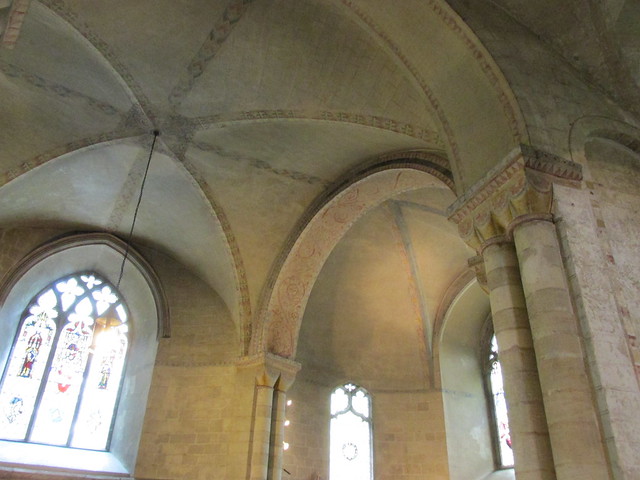Close by Norwich Castle you'll find a blue plaque which, unlike most of their kind, doesn't actually name the person it commemorates. In fact it marks a new finding about bones that were excavated in the 1990s.
The latest research techniques have allowed archaeologists to isolate DNA from the tooth pulp of a young Saxon man and he was found to possess a genetic marker from the Romani people - the earliest evidence for their presence anywhere in the UK.
The plaque reads:
Romani DNA
A skeleton discovered during excavations of an 11th century graveyard near this spot has been found to have a mitochondrial DNA marker unique to the Romani people. This is the earliest evidence for a person of Romani descent in the British Isles, and is 400 years earlier than any documentary reference to their presence.
Thursday, 30 July 2015
Friday, 24 July 2015
Cow Tower
Cow Tower in Norwich is considered to be one of the finest surviving examples of medieval brickwork in the UK. It stands by a bend in the River Wensum and we discovered it by accident during a post-prandial stroll. If you're ever in the city it's worth checking out the riverside walk because there are several interesting things to spot along the way and I'll be showing you some of them in future posts.
The tower was built as an artillery blockhouse and is one of the earliest examples. It was constructed in 1398-9 to command a strategic point in the city's defences. At the time Britain wasn't very friendly with France. A French raid had devastated Southampton in 1338, and the Peasants' Revolt of 1381 had left Norwich badly damaged. So Cow Tower could serve a dual purpose to protect the city from attacks both inside and out! It would have housed a garrison when necessary.
Norwich was walled (mostly demolished to make way for expansion in the 18th and 19th centuries) and Cow Tower strengthened those defences. It was equipped with hand cannon and bombards (large caliber, muzzle-loading artillery pieces. Gives rise to the title of Bombadier.)
Cow Tower is quite big. It's 14.6 metres (48 ft) high, 11.2 metres (37 ft) across, and the walls are 1.8 metres (5 ft 11 in) thick at the base. The brick facings have the local flint building material in their core.
It had three floors, all now sadly missing, and a staircase up the side to reach them. It takes its name from the surrounding Cowholme area, meaning a water meadow where cows are grazed.
It's now a scheduled monument in the care of English Heritage. You can't go in, but you can see the interior clearly through the original (barred) doorway.
For a detailed review click here.
The tower was built as an artillery blockhouse and is one of the earliest examples. It was constructed in 1398-9 to command a strategic point in the city's defences. At the time Britain wasn't very friendly with France. A French raid had devastated Southampton in 1338, and the Peasants' Revolt of 1381 had left Norwich badly damaged. So Cow Tower could serve a dual purpose to protect the city from attacks both inside and out! It would have housed a garrison when necessary.
Norwich was walled (mostly demolished to make way for expansion in the 18th and 19th centuries) and Cow Tower strengthened those defences. It was equipped with hand cannon and bombards (large caliber, muzzle-loading artillery pieces. Gives rise to the title of Bombadier.)
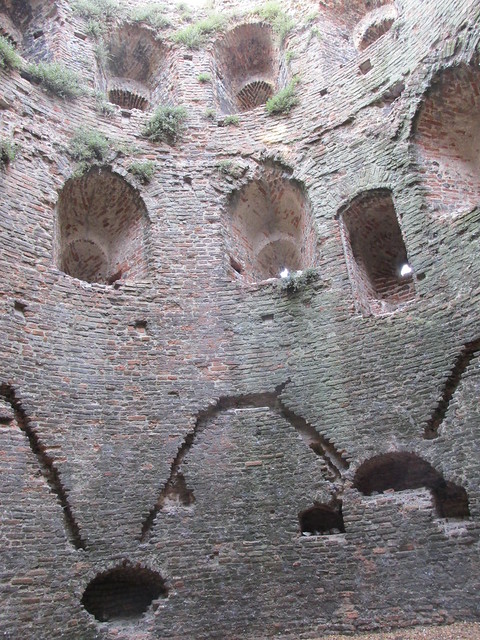 |
| Cow Tower interior |
It had three floors, all now sadly missing, and a staircase up the side to reach them. It takes its name from the surrounding Cowholme area, meaning a water meadow where cows are grazed.
It's now a scheduled monument in the care of English Heritage. You can't go in, but you can see the interior clearly through the original (barred) doorway.
For a detailed review click here.
Monday, 20 July 2015
Norwich Cathedral
When we visit an Anglican cathedral in the UK we have fairly clear expectations of what we'll find inside: soaring arches, bright stained glass, intricate carvings and stone - lots of gleaming stone. We often forget that church interiors - and in particular cathedral interiors - weren't always like that.
Only a few churches still have traces of the rich decoration that once covered their walls and ceilings, but there are remarkable survivors at Norwich, where brightly coloured and complex designs are still visible.
These decorative remains date from the 12th century. It was a time when churches also had stories from the scriptures illustrated on the walls. Most of the populace would be unable to read, so the tales were painted for them to see for themselves.
Doom paintings were also common around this time. They depicted the Christian version of what is supposed will happen on Judgement Day, when the blessed will be taken to heaven to sit at the right hand of god and sinners will be condemned to hell. Many doom paintings have vivid images of the daemons and tortures that await the unholy- a sure reason to behave according to church law!
Only a few churches still have traces of the rich decoration that once covered their walls and ceilings, but there are remarkable survivors at Norwich, where brightly coloured and complex designs are still visible.
These decorative remains date from the 12th century. It was a time when churches also had stories from the scriptures illustrated on the walls. Most of the populace would be unable to read, so the tales were painted for them to see for themselves.
Doom paintings were also common around this time. They depicted the Christian version of what is supposed will happen on Judgement Day, when the blessed will be taken to heaven to sit at the right hand of god and sinners will be condemned to hell. Many doom paintings have vivid images of the daemons and tortures that await the unholy- a sure reason to behave according to church law!
Monday, 13 July 2015
A brief history of fashion rules
| How tight will it go? |
Last year's Wimbledon saw a fuss over the colour of players' knickers and former champion Roger Federer branded the general code ('almost entirely white') as 'too strict'. It was probably originally introduced to avoid any kind of sponsorship hints creeping in.
I remember many, many years ago there was a fuss about a brand of cigarettes, aimed at women, who sponsored one of the key players (forgive me, I'm not a tennis fan so I can't remember who) by providing a playing dress with subtle - but recognisable as the pack decoration - curved brown lines on it.
But these rules don't apply to the spectators - so what about poor Lewis? I've been trying to find information on what the rules are, because I suspect that, for once, men are being judged more harshly than women over 'acceptable' dress.
A quick review
Historically women have always been told to dress in ways that were 'appropriate for polite society', but over the years the rules have changed quite a bit. For example, back in the 18th century skirts were long (no ankles visible please!) and wide; very wide.
If you think that's romantic, rather than restricting, try walking in a crinoline, or even better, sitting down in one A woman's behaviour was, of necessity, 'demure' because she couldn't physically do anything quickly while she was hampered by her skirts. Even breathing was difficult because the requirement for a narrow waist meant corsets were tight.
High heels were already in fashion and, trust me, forcing women to walk round on uneven ground so their boobs and bums stick out is not healthy. It's not as bad as binding their feet so they always have dainty pins, but it can lead to severe spinal problems and arthritis in knees and hips.
France has always been a fashion leader and changes that took place around the time of their Revolution soon took off in England as well. Post Bastille Day, skirts were narrower but the boobs came out - forced up and thrust forward by that corseting again.
Early nineteenth century the skirts started filling out again and were made from stiffer fabrics, and waists were ever smaller. It's no surprise that Jane Austen's characters were often of the fainting kind. As the century progressed the shoulders came out and busts were emphasised by that ever-present corseted waist. And by the end of it, women were back in crinolines. (Think Gone with the Wind) Even the pre-Raphaelites didn't allow their women the freedom the artists had.
The Victorians took corseting to a new level, not just restricting the waist, but creating a whole silhouette from armpits to hips. Flat fronts and big bums were the order of the day - and absolutely no showing of shoulders, ankles, or indeed skin. 'Proper' ladies wore gloves.
But some were starting to object to the restrictions. In 1881 the Rational Dress Society launched a campaign of opposition to the kind of clothing that had potential to injure health and deform the body.
The Edwardians introduced a 'health corset' that moved the pressure off the stomach but encouraged an 's' shaped spine. Everything was still very well covered and there must be absolutely no hint of chest skin. Collars were high, often covering the neck.
Of course in the 1920s women became downright disobedient and started wearing whatever they wanted. Skirts hitched higher and higher, and some even wore (saints preserve us!) trousers. And as far as some people were concerned it all went downhill from there.
So back to the Royal Box question.
It goes without saying that all of the above styles would have applied to anyone mixing with Royalty, and perhaps that's one of the driving forces behind fashion. Boobs out when Georgy Porgy was on the throne, but cover up when Victoria developed her 'we are not amused' attitudes following the death of Albert.
It's hard to track down Wimbledon's dress rules, but Ascot's are easily accessed online. Trouser suits are welcome there (suits, mind, not trousers and a shirt) but strapless, off-the-shoulder numbers that the early 19th century would have approved are now forbidden. No bare midriffs, and although it doesn't actually say that headgear is compulsory, there are strict hat rules. On no account may fascinators appear. Hats must have at least a 4 inch diameter. (Even if they do look like an upturned toilet seat!)
Gentlemen must wear formal grey or black morning suits, with a waistcoat and tie (no cravats), top hat and black shoes. Poor Lewis wouldn't have even got close there!
But the question remains, was his rather natty, floral shirt very offensive? The Wimbledon authorities clearly thought so. It looked a bit like my Grandma's curtains, but it was clean, pressed and probably cooler than a jacket for a hot day. So is it time to change the rules?
Saturday, 11 July 2015
How old is history?
What the heck - it's the weekend.
For my purposes today, 1991 counts.
It's taken from an album called The NY Rock and Soul Revue that is scarily almost 25 years old. That's part of MY history.
Check it out here. (That should open in a new window.)
For my purposes today, 1991 counts.
It's taken from an album called The NY Rock and Soul Revue that is scarily almost 25 years old. That's part of MY history.
Check it out here. (That should open in a new window.)
Friday, 10 July 2015
History wherever you look - fire plaques
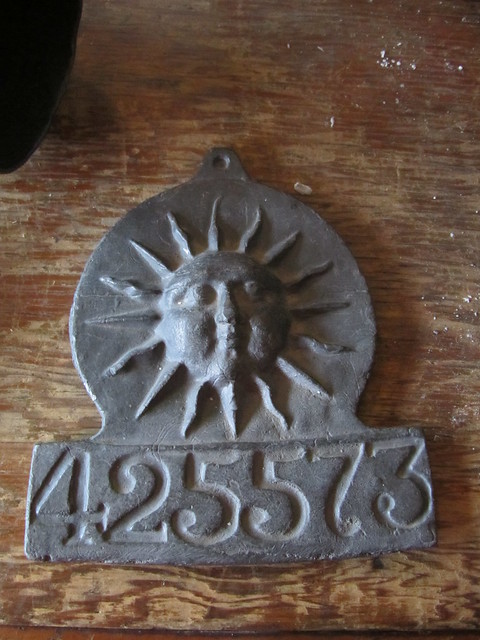 Until the 19th century there were no town fire services in the UK. Insurance companies had their own fire engines and firemen. The world's first municipal fire service was set up in Edinburgh after the Great Fire of in 1824 destroyed much of the city's Old Town.
Until the 19th century there were no town fire services in the UK. Insurance companies had their own fire engines and firemen. The world's first municipal fire service was set up in Edinburgh after the Great Fire of in 1824 destroyed much of the city's Old Town.Before that people paid insurance companies and displayed their 'certificates' in the form of plaques on the front of their building. Many had dates to demonstrate that the year's premium had been paid. No up-to-date plaque, no fire fighting!
Once town brigades were established the insurance companies tended to leave the badges in place as adverts. Such plaques can still be seen on the front of old buildings. Some even have the name of companies that have survived to the present day.
The plaque in the photo is at Blists Hill Victorian town - part of the Ironbridge Gorge group.
Monday, 6 July 2015
Forth Bridge gets World Heritage status
The iconic Forth Bridge (the big red one that carries the railway) has been given World Heritage status by Unesco.
The bridge is a mile and a half long and crosses the Firth of Forth north of Edinburgh. At the time of its opening in 1890 it was the longest cantilever bridge in the world, and used the highest standards of engineering available.
Its maintenance was immortalised in the phrase 'like painting the Forth Bridge', meaning a never-ending job, but new products and methods mean that the task was finally finished in 2011 and the structure won't need painting again for another 20 years!
You can read more about the bridge, and one of its contemporaries, on the History Anorak website.
The bridge is a mile and a half long and crosses the Firth of Forth north of Edinburgh. At the time of its opening in 1890 it was the longest cantilever bridge in the world, and used the highest standards of engineering available.
Its maintenance was immortalised in the phrase 'like painting the Forth Bridge', meaning a never-ending job, but new products and methods mean that the task was finally finished in 2011 and the structure won't need painting again for another 20 years!
You can read more about the bridge, and one of its contemporaries, on the History Anorak website.
Saturday, 4 July 2015
Well dressing
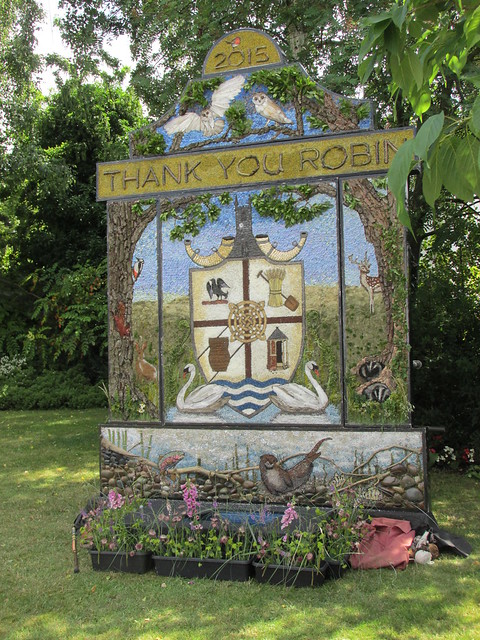 The origin of well dressing is not known. At one time it was mainly carried out around Derbyshire, but over the last couple of decades it has spread across the Midlands. In spite of the name the events are not always centred on a well, although the longest-running traditions still are.
The origin of well dressing is not known. At one time it was mainly carried out around Derbyshire, but over the last couple of decades it has spread across the Midlands. In spite of the name the events are not always centred on a well, although the longest-running traditions still are. Many people believe that the tradition grew up from pagan practices that honoured water gods. The ceremonies ensured villages would maintain a clean drinking supply. However, the tradition does not date back indefinitely into the past.
During the 17th century many villages in Derbyshire were affected by the plague, and it is possible that well dressing was revived by the Church of England to give thanks for those who survived.
Some villages, such as Youlgrave (which is Youlgreave if you check the sign at the other end of the village!) began the ceremonies when piped water arrived. Those events were called tap dressings and took place at the parish pump.
Originally the wells were celebrating by placing quite small posies of flowers but over the years they have become more elaborate. These days huge wooden frames are filled with clay and then flower petals and other natural objects are pushed into them to create pictures. They can be traditional or contemporary - serious or comic.
The choice of materials can be very creative. The dressing in the photo was the main one of nine at Aston-on-Trent this year. A list was posted next to it describing what had been used. It included alder cones, leaves, bark, coal, coconut, fresh and dried parsley, coriander, sage, dog hair, feathers, grass, lavender, leeks, oats, pebbles, millet, wool, twigs, shells, soot, rice, tapioca, turmeric, peppercorns, sand and coffee, among other things!
The events carry on across the district throughout the summer. The frames are left in place until the flowers fade - usually about a week or 10 days. The exact time depends on the placement. North-facing lasts longer, and it's best to avoid direct sunlight. At some point a procession or blessing ceremony will be held to consecrate the dressing.
The pictured dressing commemorates Robin Gibbard, an Aston resident who established the modern tradition of holding a well dressing in the village. He has been the driving force behind many recent dressings and some parts of this one - the owls and the otter - reference his past designs. There isn't actually a well on the spot these days, but the name of the adjoining cottage - Pump House - shows that there once was!
Subscribe to:
Comments (Atom)



